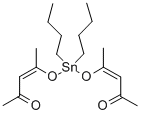DIBUTYLTIN BIS(2,4-PENTANEDIONATE)

|
- ₹11896.68
- Product name: DIBUTYLTIN BIS(2,4-PENTANEDIONATE)
- CAS: 22673-19-4
- MF: C18H32O4Sn
- MW: 431.15
- EINECS:245-152-0
- MDL Number:MFCD00077994
- Synonyms:DI-N-BUTYLTIN BIS(ACETYLACETONATE);DI-N-BUTYLTIN BIS(2,4-PENTANEDIONATE);DI-N-BUTYLBIS(2,4-PENTANEDIONATE)TIN;DIBUTYLTIN BIS(ACETYLACETONATE);DIBUTYLTIN BIS(2,4-PENTANEDIONATE);di-n-butyltinbis(acetylacetonate),tech.,95% ;dibutylbis(pentane-2,4-dionato-O,O')tin ;Tin, dibutylbis(2,4-pentanedionato-.kappa.O,.kappa.O)-, (OC-6-11)-
1 prices
Selected condition:
Brand
- Sigma-Aldrich(India)
Package
- 500ML
- ManufacturerSigma-Aldrich(India)
- Product number520586
- Product descriptionDibutyltin bis(acetylacetonate) 95%
- Packaging500ML
- Price₹11896.68
- Updated2022-06-14
- Buy
| Manufacturer | Product number | Product description | Packaging | Price | Updated | Buy |
|---|---|---|---|---|---|---|
| Sigma-Aldrich(India) | 520586 | Dibutyltin bis(acetylacetonate) 95% | 500ML | ₹11896.68 | 2022-06-14 | Buy |
Properties
Melting point :26 °C(lit.)
Boiling point :150 °C(lit.)
Density :1.22 g/mL at 25 °C(lit.)
vapor pressure :0.038Pa at 25℃
refractive index :n20/D 1.5110(lit.)
Flash point :130 °F
form :liquid
Specific Gravity :1.21
color :pale yellow to amber
Hydrolytic Sensitivity :4: no reaction with water under neutral conditions
Exposure limits :ACGIH: TWA 0.1 mg/m3; STEL 0.2 mg/m3 (Skin)
NIOSH: IDLH 25 mg/m3; TWA 0.1 mg/m3 EPA Substance Registry System :Tin, dibutylbis(2,4-pentanedionato-.kappa.O2,.kappa.O4)-, (OC-6-11)- (22673-19-4)
Boiling point :150 °C(lit.)
Density :1.22 g/mL at 25 °C(lit.)
vapor pressure :0.038Pa at 25℃
refractive index :n
Flash point :130 °F
form :liquid
Specific Gravity :1.21
color :pale yellow to amber
Hydrolytic Sensitivity :4: no reaction with water under neutral conditions
Exposure limits :ACGIH: TWA 0.1 mg/m3; STEL 0.2 mg/m3 (Skin)
NIOSH: IDLH 25 mg/m3; TWA 0.1 mg/m3 EPA Substance Registry System :Tin, dibutylbis(2,4-pentanedionato-.kappa.O2,.kappa.O4)-, (OC-6-11)- (22673-19-4)
Safety Information
| Symbol(GHS): |
    
|
|||||||||||||||||||||||||||||||||||||||||||||||||||||||||||||||
|---|---|---|---|---|---|---|---|---|---|---|---|---|---|---|---|---|---|---|---|---|---|---|---|---|---|---|---|---|---|---|---|---|---|---|---|---|---|---|---|---|---|---|---|---|---|---|---|---|---|---|---|---|---|---|---|---|---|---|---|---|---|---|---|---|
| Signal word: | Danger | |||||||||||||||||||||||||||||||||||||||||||||||||||||||||||||||
| Hazard statements: |
|
|||||||||||||||||||||||||||||||||||||||||||||||||||||||||||||||
| Precautionary statements: |
|
Description
Cross-linking agent, catalystRelated product price
- TIN (II) ACETYLACETONATE
₹10911.6 - DIBUTYLDIMETHOXYTIN
₹2400-8300 - 22673-19-4
₹11896.68






